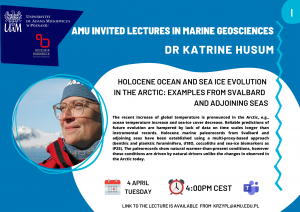Serdecznie zapraszamy do wzięcia udziału w wykładzie online pod tytułem “ Holocene ocean and sea ice evolution in the Arctic: examples from Svalbard and adjoining seas” , który wygłosi dr Katrine Husum (Norwegian Polar Institute, TRomso, Norwegia). Wykład stanowi część serii “AMU Invited Lecture Series in Marine Geosciences I” organizowanej przez Uniwersytet im. Adama Mickiewicza w ramach programu IDUB. Wykład odbędzie się we wtorek (4 kwietnia) o godzinie 16:00 na platformie MS Teams.
W przypadku problemów link jest dostępny od dra Krzysztofa Pleskota (krzypl@amu.edu.pl). Wykład i otwarta dyskusja po wykładzie będą w języku angielskim.
Informacja o wykładowcy i wykładzie:
Dr Katrine Husum is a senior scientist at the Norwegian Polar Institute. She is an authority on high-latitude ocean and sea ice evolution over the Quaternary, specializing in marine micropalaeontology and biogeochemistry. She has authored over 100 peer-reviewed papers in international scientific journals (H=34), has supervised numerous graduate students (amongst them, 9 PhDs), and has led over 20 ship-based scientific expeditions as chief scientist. She has furthermore served as editor of several peer-reviewed scientific journals, including Marine Micropaleontology and Arktos.
The abstract of the lecture:
The recent increase of global temperature is pronounced in the Arctic, e.g., ocean temperature increase and sea-ice cover decrease. Reliable predictions of future evolution are hampered by lack of data on time scales longer than instrumental records. Holocene marine paleorecords from Svalbard and adjoining seas have been established using a multi-proxy-based approach (benthic and planktic foraminifera, d18O, coccoliths and sea-ice biomarkers as IP25). The paleorecords show natural warmer-than-present conditions, however these conditions are driven by natural drivers unlike the changes in observed in the Arctic today.
